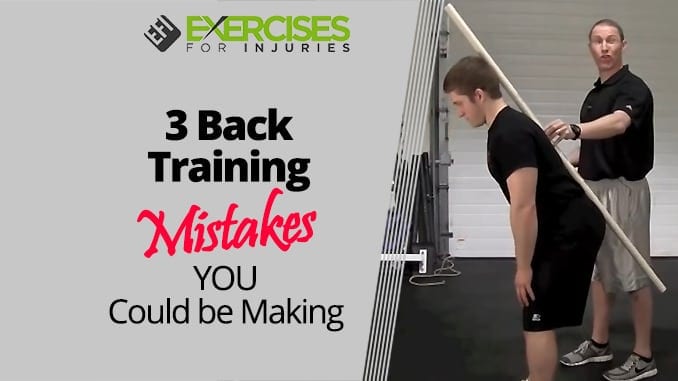
Got some great information for you today. It is from a strength coach that I brought into Vancouver to share his knowledge on how to Bulletproof Your Knees and Back.
The seminar was fantastic!
I got some clips of the seminar below.
The great thing is that Mike recorded the entire 16-hour sem ar. If you missed the fantastic seminar, you could check it out here: let’slet’s get into the great info; take it away, Mike. We’ve all heard the stats – 80% of Americans will suffer from lower back pain at some point time in their lives. As trainers, coaches, and therapists, our goal is not only to get them healthy but also to keep them healthy.
The question then becomes – are your coaching and training making your clients better?
Or, in a worst-case scenario, possibly making them worse?
Below are the three biggest coaching mistakes I see trainers and coaches making regarding back pain.
While they may seem simple at first blush, these are the tools that make our team at IFAST incredibly successful at working with everyone from the injured and beat-up “corrective exercise” client up to high-level performance athletes.
1. Not Training Neutral Spine
Neutral spine is a concept that Panjabi first discussed as far back as 992. The hypothesis was simThere’sere “s a “neutral” zone” where your spine is happy and healthy.
The further you move from “hat “neutral “one,” the more likely you are to get injured!
Coaching a neutral spine is incredibly easy. All you need is 4′ a 4′ piece of PVC pipe that you can carry around during training sessions. While many have seen this tool used on core training exercises such as front planks, side planks, and bird dogs, its use is unparalleled.
Instead of coaching and cuing neutral spine on core exercises, start using it on virtually all of your big bang lower body exercises. Most clients will be shocked at how quickly they deviate from neutral they’re asked to squat, deadlift, or lunge with a neutral spine.
And if you think this is just too simple or won’t, where some food for thought.
I attended a seminar several years ago where strength coach Joe Kenn discussed the power clean. He mentioned that one of the first things he does is put the PVC pipe on athletes’ backs to teach them neutral spine!
Coach Kenn has worked at major universities like Boise State, Utah, Arizona State, and Louisville. And by he’s now the head strength coach for the Carolina Panthers of the NFL, it’s good enough for Coach Kit’s; it’s good enough for me!
2. Not Understanding the Role of Neutral Pelvis
Intuitively, a neutral spine makes a lot of sense to people. Unfortunately, the pelvis tends to get lost in the shuffle.
Why is this a problem, you might wonder?
Simple – all the body joints are intimately connected to and influence the other joints. When you change the position of your foot, this can drive changes up your kinetic chain!
The pelvis has a direct connection to the lumbar spine. If your clients are walking around with a massive anterior tilt of the pelvis, this will increase the lordosis of their lumbar s ne as such doesn’t make sense to hammer your clients with a neutral spine without also working to achieve a neutral pelvis!
My two favorite exercises for mastering the neutral pelvis are half-kneeling and tall-kneeling Exercises. I recently gave a presentation at the NSCA conference outlining these two tools, and afterward, an attendee came back and asked me what else I did to reinforce a neutral alignment.
I hated to break it to him, but this was it!
The key, however, is putting your client in these positions numerous times during their wor out. For example, if someone is coming to me and needs to hammer a neutral pelvis, we could efficiently perform 2-3 tall- or half-kneeling exercises in each workout to make sure we drive home the concept!
Dan John always says that if something is important, do it every day. My clients may not be in the gym every day, but when they are there, we will spend the bulk of the time addressing their weaknesses.
3. Not Focusing on the Details
shouldn’t come as a surprise, but the devil is in the details when it comes to training people in back pain.
A few years ago, we had a client with debilitating back pain that came into our gym for several weeks. He complained of pain during his 2nd or 3rd workout and told me he couldn’t work out.
Never one to accept defeat, I told let’s go through your warm-up and see how you feel.
We got him loosened up a bit, and he started feeling be there. Next, I asked him to try going through the exercises as best he could, and if he had any pain, we could immediately stop.
We got him through his entire workout that day without one single tweak or flare-up. He was pretty shocked.
The details are critical; when someone comes in with back pain, here are some suggestions to get them through their workout pain-free:
- Ask them to just go through the war-up. Often some gentle stretching, foam rolling, and movement will get them feeling better immediately.
- You must coach every set of every rep. Decrease the load, decrease the range of motion, whatever is necessary, but you must be 100% dialed into your client and their wor out. Any deviation from good alignment or lack of attention on your part could get them injured!
Summary of the Back Training Mistakes
Back pain is an epidemic. Americans spent $90 BILLION in 2006 alone treating their low back pain.
If you adhere to the simple guide I’ve provided, you’ll be well on your way to becoming the go-to back expert in your area. You never have a shortage of patients and clients walking in your door!
Mike Robertson has helped clients and athletes from all walks of life achieve their strength, physique, and performance-related goals.
He received his Masters’s Degree in Sports Biomechanics from the world-renowned Human Performance Lab at Ball State University.
Mike is the president of Robertson Training Systems and the co-owner of Indianapolis Fitness and Sports Training, named onAmerica’sica’s Top 10 GymMen’sMen’s Health magazine in 2009 and 2010.
Before I go, if you like the info ve. Watch for Muscle Imbalances Revealed – Upper Body Edition, where Tony Gentilcore, Dean Somerset, and Dr. Jeff Cubos will share their tips, tricks, and exercises for upper body training. Mark down the date; it will be coming out Tuesday, August 9, 2011.
Rick Kaselj, MS
Clip from the Bulletproof Knees and Spine Seminar:
If you are interested in learning from the best in the world, think about coming out to one of these courses in Vanco er. Big names like Eric Cressey and Mike Robertson have taught total weekend seminars – something they never do. Coming up this fall is Nick Time o. Make sure to mark down November 19 & 20, and we will see you in Vancouver.


